
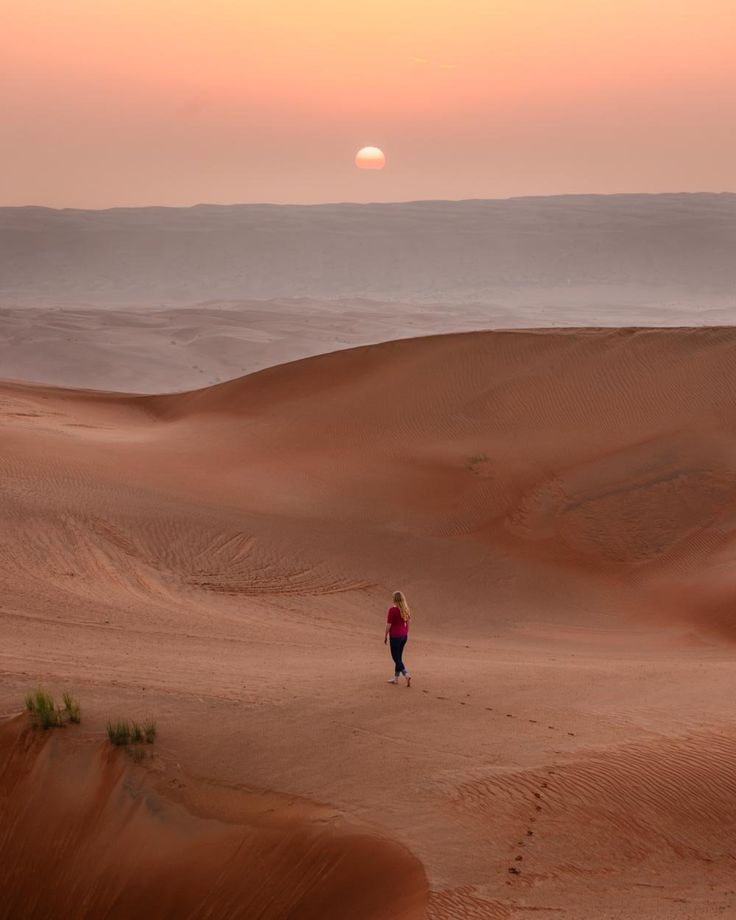
Wahiba Sands Oman: The Hidden Desert Paradise You Never Knew Existed
Wahiba Sands Oman is a massive desert paradise that stretches over 12,000 square kilometers. Magnificent dunes tower up to 100 meters high in this natural wonder. The area, also known as Sharqiya Sands, sits just a 2-hour drive from Muscat and provides a perfect escape into pristine desert wilderness.
Our research found that visitors can best explore this hidden gem from October to April. The desert blends adventure and tranquility perfectly. Guests can enjoy thrilling dune bashing and peaceful camel rides under starlit skies. Simple camping and luxury glamping options await overnight visitors. This golden expanse of sand promises an unforgettable experience into Oman’s natural heritage, whether you seek heart-pumping desert adventures or quiet moments under clear night skies.
The Natural Wonder of Wahiba Sands
The majestic Wahiba Sands lies in eastern Oman. This stunning desert stretches 180 kilometers north to south and 80 kilometers east to west. The Indian Ocean marks its eastern edge, while regular floods from wadis Indam and Halfayn stop it from spreading westward.
Location and geography
The desert’s perfect location makes it easy to reach from Muscat – just a few hours away. This amazing terrain covers 12,500 square kilometers and creates a mesmerizing landscape that shows nature’s artistic beauty. Hidden groundwater reservoirs beneath the surface help sustain a surprising variety of life forms.
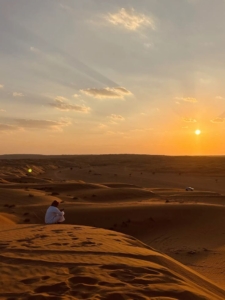
Unique sand dune formations
The desert’s dune formations create a stunning display that varies across different areas:
- Northern region: Mighty reddish stratified dunes run parallel and reach heights of 20 meters
- Southern area: Beautiful white, sickle-shaped formations dominate the landscape
- Coastal zone: A remarkable sea of fossilized sand dunes sometimes breaks through the surface in strange shapes
These dunes move up to 10 meters each year, making permanent roads impossible. The golden giants line up north to south in surprisingly regular patterns, shaped by constant winds.
Desert climate patterns
Wahiba Sands’ climate follows typical desert patterns with big temperature swings between seasons. Summer months from May to September bring extreme temperatures that make exploration difficult. Winter months from October to April offer milder conditions – the perfect time to visit the desert.
The ocean’s nearness affects the desert’s climate and provides enough moisture to support a rich ecosystem. A Royal Geographical Society expedition in 1986 proved this abundance. Scientists found over 16,000 invertebrate species and 200 other wildlife species. This amazing biodiversity exists thanks to hidden underground water reserves that support life in this seemingly harsh environment.
Life in the Desert Ecosystem
The golden dunes of Wahiba Sands hide an incredibly rich ecosystem. A 1986 Royal Geographical Society expedition found 16,000 invertebrate species and 200 species of other wildlife. This remarkable biodiversity survives through complex survival mechanisms and hidden underground water reserves.
Native desert plants
Hardy vegetation dominates the desert landscape with over 400 plant species. Ghaf trees (Prosopis cineraria) are the flagship species. Their deep roots reach underground water sources. These tough trees give essential shade and stability to the desert ecosystem. The northern coastal section has unique shrubs like sea-lavender and Zygophyllum qatarense.

Desert wildlife
Several remarkable species make up the desert’s diverse fauna. The Arabian oryx, once nearly extinct, now roams these sands in growing numbers. The area also has an impressive array of wildlife, including sand cats, Ruppel’s fox, and the near-threatened striped hyena.
The bird population is rich. Desert areas are home to:
- Endangered Houbara Bustard
- Sand partridge
- Desert larks and pipits
- Four distinct sandgrouse species
Adaptation strategies
Desert inhabitants have developed fascinating ways to survive. These species have evolved unique adaptations instead of fighting harsh conditions. Desert plants show incredible resilience and use various strategies to save water. They have smaller leaves and specialized water storage organs.
Desert animals stay underground in burrows where air remains cool and humid. Most are active at night or twilight. The mammals in these sands show remarkable adaptive traits in their fat metabolism and insulin signaling. Many species have developed special behaviors to minimize water loss. Some rodents can survive just on metabolic water from their food.
The ecosystem’s survival depends on how its inhabitants work together. The ghaf woodlands provide important nesting spots for birds and vital shade for the vulnerable Arabian gazelle. Life in Wahiba Sands shows nature’s amazing ability to thrive in the toughest conditions.
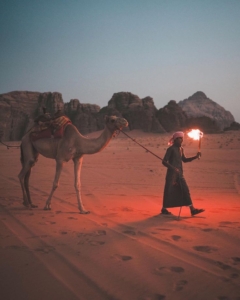
The Bedouin Heritage
Bedouin communities in Wahiba Sands maintain a remarkable balance between their ancient traditions and modern life. Their lifestyle shows how they adapt to desert living, a wisdom passed down through generations.
Traditional lifestyle
Bedouin culture’s heart lies in its exceptional hospitality. Guests who enter a Bedouin tent receive a warm welcome with traditional Omani coffee (qahwa) and dates. The coffee ritual tells its own story – they brew it with cardamom and sometimes saffron, serve it in small cups, and follow precise customs that represent trust and friendship.
Rich carpets and cushions fill a Bedouin home, creating cozy spaces where families gather and share stories. Their living spaces blend practicality with tradition, featuring spacious majlis (gathering areas) that let air flow easily. Modern conveniences now exist in these desert homes – cooking gas has taken the place of wood fires, and water tankers visit weekly.
Bedouin life starts early with prayers, then flows into household activities. Camels play a special role in their culture beyond just transportation – they’re valuable assets. Many families raise racing camels that can sell for up to RO10,000.
Desert navigation skills
Bedouins have become skilled at desert navigation, one of their most impressive achievements. They created sophisticated ways to guide themselves across the big, changing landscape before modern technology existed. Their navigation methods include:
- Reading footprints and tracks in daylight
- Using rocks and shadows as makeshift sun compasses
- Reading dune shapes and rock erosion patterns based on common winds
- Using trail marking stones called “rojoms” in difficult terrain
The best Bedouin guides know how to use all their senses to find their way. When visibility is poor, they feel the slopes’ contours with their feet and identify terrain changes through touch and balance. Years of experience create rich mental maps that help them navigate in challenging weather.
Their navigation excellence comes from knowing their tribal territory intimately. Mountain peaks, wadis, and basins serve as reference points. Permanent landmarks – distinctive rocks and lone trees – offer subtle clues about routes and turning points.
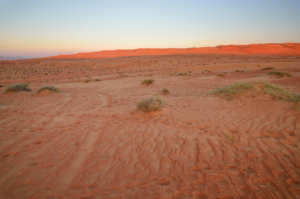
Desert Activities and Experiences
The golden dunes of Wahiba Sands draw adventurers with exciting activities that show off the desert’s raw beauty and charm.
Dune bashing adventures
Dune bashing is a thrilling highlight for adventure seekers. Skilled drivers direct powerful 4×4 vehicles through towering dunes to create an amazing experience. The vehicles need proper preparation before these trips. Drivers must lower tire pressure to move better on sand.
Omani guides show incredible skill as they predict weather patterns and move through tough terrain. They take guests on standard routes and give them special experiences like climbing almost vertical dunes with quick turns. Safety comes first, and these guides know how to handle surprises. They can even direct vehicles through fierce sandstorms when needed.
Camel treks
Camel trekking gives visitors a peaceful way to see the desert. These “kings of the desert” let you explore the vast sands naturally. You can choose from short rides to longer adventures that include:
- Visits to Bedouin camps with Arabic coffee and dates
- Full-day trips across high sand dunes
- Long treks between Bedouin villages
These trips let you feel the desert’s pace just as Bedouins have for hundreds of years. The slow, gentle movement of riding a camel creates a relaxing feeling, especially on longer trips.
Stargazing opportunities
Wahiba Sands becomes a stargazer’s dream as day turns to night. The dark skies create perfect conditions to see countless stars and planets. The remote desert location lets you see the night sky in all its glory.
Full moon nights make the experience magical as the dunes glow with an otherworldly light. You can join guided night walks and learn about planets and star patterns visible from this perfect spot. People gather around campfires during stargazing sessions. Experts share astronomy facts while the quiet desert adds to the mystical mood.
The best months to visit are October through March when the weather is just right. Many visitors mix different activities to get the full desert experience. They might start with afternoon dune bashing, watch the sunset from a camel’s back, and end their day stargazing.
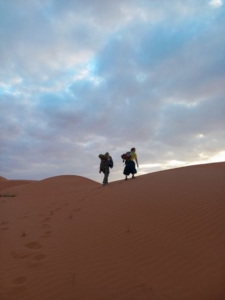
Sustainable Desert Tourism
Wahiba Sands needs a perfect balance between tourism growth and environmental protection. The Sultanate of Oman has taken important steps toward green desert tourism. These practices protect both the environment and local heritage.
Eco-friendly practices
Water conservation is the lifeblood of sustainable tourism in Wahiba Sands. Agriculture uses over 80% of groundwater for irrigation. Tourism facilities now follow strict water management protocols. Oman’s tap water ranks among the world’s best, with 97% free from contamination. Visitors are asked to use water carefully.
These sustainable initiatives help curb plastic pollution:
- Promoting refillable water containers over single-use bottles
- Installing water refill stations at major tourist points
- Asking visitors to buy larger water containers when needed
Desert camps like Al Salam Camp lead the way in green practices. These places use solar energy and sustainable building materials that reduce environmental effects. Many hotels and resorts now run detailed waste reduction programs and renewable energy solutions.
Supporting local communities
Tourism money in Wahiba Sands reaches way beyond visitor spending. Local communities thrive through various programs that preserve traditional ways of life and create lasting income sources. Villages like Misfat Al Abriyeen show how eco-tourism helps community well-being.
Tourism development programs aim to maximize local value. Tour operators work with Bedouin communities to create jobs and support traditional crafts. Local guides share their desert navigation skills and wildlife conservation knowledge. This enriches visitor experiences and keeps cultural authenticity intact.
The Sultanate’s new tourism associations boost local businesses. These groups create programs that showcase Oman’s cultural and natural treasures. Local communities receive direct economic benefits. Visitors can support the local economy by:
- Choosing locally owned and operated accommodations
- Buying handicrafts directly from artisans
- Joining community-led tourism initiatives
Small group tours grow more popular each year. They offer personal experiences and leave minimal environmental impact. Tour operators support local conservation through regular clean-up drives and reforestation projects. This tourism approach preserves Oman’s unique cultural legacy and improves local lives.
Visitor participation drives these initiatives’ success. Travelers who pick eco-friendly accommodations and support local businesses help Wahiba Sands’ tourism industry last longer. This shared approach means future generations can experience this desert paradise’s magic while protecting its natural and cultural heritage.

Conclusion
Wahiba Sands shows evidence of nature knowing how to craft stunning landscapes that support life in many forms. Our journey through this hidden paradise revealed a perfect balance of age-old traditions and modern adventures. The desert’s massive dunes provide shelter to countless species. Bedouin communities keep their rich cultural heritage alive through eco-friendly ways.
The desert’s magic shines brightest at night. The stars fill the sky and turn it into a natural theater. Each moment here adds something special – racing on golden dunes, gentle rides on camel back, or swapping stories by the campfire.
This unique ecosystem runs on careful protection and smart tourism choices. Local people put their hearts into protecting their homeland and sharing its beauty with guests. Their soaring win shows that responsible tourism can save these natural treasures for tomorrow’s visitors.
Without doubt, Wahiba Sands gives you more than a regular desert trip. You’ll find a real connection with nature’s pure beauty and genuine Bedouin warmth. Anyone looking to break free from typical travel spots will be fascinated by this special corner of Oman. Book Now!
